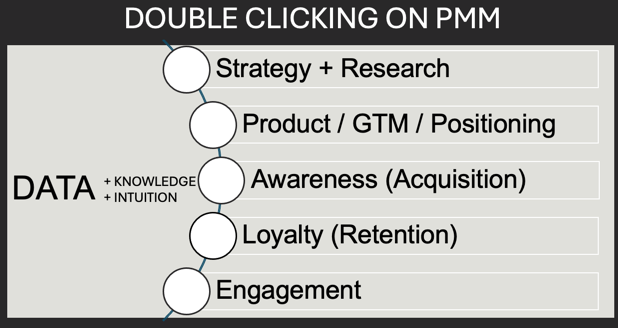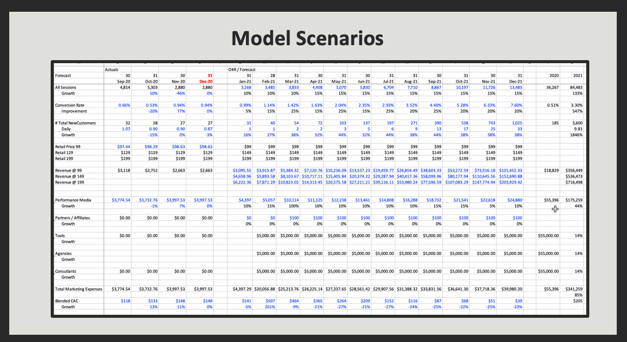Overall Strategies & Frameworks
At the core, shopping behaviors are generally similar for B2C and B2B, and there’s a reason why there are target audiences. Why are resources allocated to research the ideal buyer for a business? It’s because B2B consumers and B2C consumers are, in fact, different. Their decision-making processes vary from each other. And very similar still.
As marketing and sales professionals, it’s important to recognize that the sales cycle for B2Cs and B2Bs have distinct differences that drive varying strategies for converting new leads. Yet, for the most part, they are very similar.
A purchase funnel, whether business-to-business (B2B) or business-to-customer (B2C), visually illustrates a customer’s journey from the first contact to purchasing a product or service. It’s an opportunity for a sales and marketing team to get into the mindset of the ideal buyer and identify how to move them through the sales funnel.
So where does Product Marketing fit in, and what does that mean?
Product Marketing
It’s almost impossible to define what is Product Marketing. Its definition is different across most organizations.
What is consistent across organizations is that Product Marketing sits at the heart, the intersection, and the core of all successful companies. PMMs collaborate with key teams such as product management, marketing, sales, and customer success and play a critical role in helping the business achieve its goals.
Double Clicking on PMM
Again, PMM collaborates across the organization to meet customer needs. They lead certain aspects and work closely with other teams.
Data: A critical to driving decision-making. It comprises quantitative (what) and qualitative (why) information. However, intuition can also inform decision-making at times.
Strategy & Research: PMM helps create strategy and completes research; this is not doesn't happen in a silo. They partner closely with Product and many teams.
Product / GTM / Positioning: Again, this work here doesn't happen in a silo. PMM works closely with Product to create new products/features, GTM, and Positioning, as well as with Marketing to ensure all are on the same page.
Awareness (Acquisition): They work closely with the Marketing team to ensure consistency in branding and Positioning across all channels.
Loyalty (Retention): They may work with Lifecycle Marketing (e.g., email, SMS), or they may lead this area. They will also work closely with Product on any features that may need to be created.
Engagement: They partner with Lifecycle, Product, and Content teams to ensure customers return and engage with the services.
Customer Journey
Questions to ponder:
What is the target market audience?
Is there product market fit?
What do conversion rates look like?
What are CAC by channels?
What are retention rates by channel?
LTV by channel?
Motivations and intent vary. Personas, brand, customer segmentation, personalization, and channel traffic all play important roles in conversion, retention, and LTV.
Every customer’s journey is unique so it’s critical to ensure the right message is being sent at the right time to help with each customer’s journey.
Channel Strategy
Know where the customers are—and they are everywhere in today’s multi-channel world. Not all customers or channels are created equal, so choosing the right one(s) is important, too. One channel might have a better CAC, while another channel might have higher-value customers (LTV).
Model & Measure - Pivot or Scale
It’s essential to model various scenarios that will help define what success AND failure might look like. As well as:
– Define how to measure success or failure.
– DON’T be afraid to fail quickly and pivot.
– DO double down to scale successes.
– Measure & track each channel to understand ROI.
The hypotheses might be wrong, so experimenting, testing, learning, and iterating are very important to be well informed by tracking and measuring results.
My experience has taught me to trust the data measured (both quant and qual) and leverage instinct to inform decision-making. This ensures that every decision is backed by solid insights, leading to more confidence in what you learn—the good and the not-so-good.
Obsess over the Funnel
A leaky or poor funnel impacts all business parts: revenue, conversion, campaign ROI, NPS, and C-SAT.
Where is the drop-off, and is any of it preventable?
Experiment. Rapidly Test. Learn. Iterate.
Identify opportunities, fix leaks, and optimize for efficiency and scalability.
Email is Critical in the Strategy
Email is only critical when the audience is segmented. A one-size-fits-all approach will not bring the desired results.
Each segment is at a different point in their journey, and the messages sent should reflect that. Sending the “right message at the right time” will significantly improve conversion and retention.
Once segmented, email provides a direct, personalized way to communicate with customers, allowing for targeted messaging, high ROI, customer retention (CRR), and the ability to measure results effectively. It is also a cost-efficient channel to reach a large audience and nurture relationships over time.
As noted in the image, some pretty impressive statistics showing emails are essential to a marketing strategy.
Email stats pulled from:
https://venngage.com/blog/email-stats/
https://www.nutshell.com/blog/email-marketing-statistics








